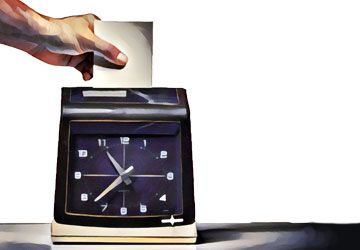Requiring Dental Employees to Clock Out Could be Costly
Depending on state laws and practice work policies, requiring your dental practice employees to clock out whenever they go on break could be problematic. The legal implications of clock in and clock out times can carry more risks than may appear on the surface. Understanding the ins and outs of employee hours could help avoid costly lawsuits and maintain employee morale.

There are many legal requirements that you need to be aware of before requiring your dental practice employees to clock in and out.
The difference between “on the clock” and “off the clock” at work may seem self-explanatory where being paid is concerned. However, that is not always the case.
“Anything that’s legal is pretty much not ever going to be clear-cut,” says Shanna Wall, a compliance attorney with the Pompano, Florida-based ComplyRight.
Resulting confusion could be problematic for dentists who require staff, particularly hygienists, to clock out either during break, or when they’re not working on a patient or handling other dental practice-related responsibilities.
WHO IS ENTITLED?
Wall explains that when it comes to breaks or who must clock in and out, and why, the focus is on non-exempt employees. They are paid hourly for time spent actively working, versus exempt employees who are being paid a set salary for whatever work they do that week.
Even then, there is still a great deal of misunderstanding because most workers believe they are entitled to breaks. However, there is no federal law requiring break times or meal times.
“Where it gets murky is that individual states may have requirements which need to be followed,” Wall says.
Almost every employer offers a break because it is good for company morale, Wall says. What is required, however, is that if a non-exempt employee takes a break fewer than 15 minutes, they do not have to clock out. With longer breaks, such as a meal break of 25 minutes or more, employers can require they clock out.
Wall adds that employees on break cannot perform any work whatsoever. “They can’t answer a quick email on their lunch break or answer the phones. If they do any work at all, [employers] have to pay them for that time.”
CANCELLED APPOINTMENTS
Beyond break time, imagine a patient phones to cancel their hygienist appointment the same morning of the scheduled visit. With little time to fill that open slot, it is possible the hygienist will be sans patients for that hour.
“You’re no longer talking about a break period,” Wall explains. “You’re talking about what constitutes an hour worked. That’s a little bit different.”
If an employee is scheduled at the practice and they are there and willing to work, they must be paid, unless there is a prior arrangement or contract indicating they are paid per appointment. Depending on how the practice is run, that could also be time the worker uses to catch up on paperwork or other practice-related responsibilities.
“If you’re going to have an arrangement with them that you’re not going to pay them anytime there’s a cancellation, then absolutely not. They cannot do any kind of work,” Wall says. “If any work is done or anything is done to benefit the employer, they need to be paid for that.”
ENGAGED OR NOT
Then there is the matter of whether an employee is “engaged to wait,” or “waiting to be engaged”—neither of which has anything to do with planning a wedding. Engaged to wait refers to an employee working under the Fair Labor Standards Act and is therefore entitled to compensation. In contrast, an employee waiting to be engaged is not considered to be working.
Let’s say an employee is scheduled to work 9 a.m. until 5 p.m. and the bus they take to work drops them off at 8:30 a.m. If they are a non-exempt employee paid hourly, they sit at their desk but they cannot work unless they receive authorization. They cannot even start setting up the exam rooms. That employee is “waiting to be engaged.”
Suppose it is after 9 a.m. and a freak storm knocks out the power at the practice. Nobody can do anything because systems are all down. That is not the employee’s fault.
“It’s not like you can require them to clock out,” Wall says. “They’re there, they’re willing to work, and they’re able to work. It’s circumstances beyond their control that are preventing them from working. You’re going to pay them for that time.” That employee is “engaged to wait.”
COMMUNICATION AND TRAINING
To avoid problems or misunderstandings, Wall recommends having written policies in place. If you’re hit with a lawsuit because an employee claims they were not paid properly for the hours they worked, those written policies can be used as a defense in a lawsuit.
Communication, Wall adds, as well as properly training managers is very important to ensure everyone understands the policies in place.
“Especially for smaller practice,” she says. “When you don’t pay somebody correctly, you’re opening yourself up to attorney fees which, many times, are double or quadruple the unpaid balance you owe the employee, plus the time to defend a lawsuit. And then you’ve got a real mess.”
ACTIVA BioACTIVE Bulk Flow Marks Pulpdent’s First Major Product Release in 4 Years
December 12th 2024Next-generation bulk-fill dental restorative raises the standard of care for bulk-fill procedures by providing natural remineralization support, while also overcoming current bulk-fill limitations.